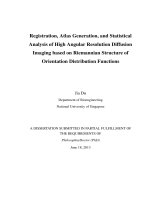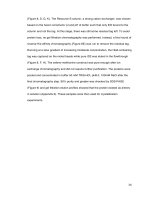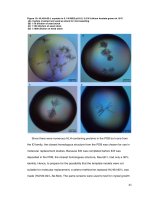Mathematical and computational analysis of intracelluar dynamics 6
Bạn đang xem bản rút gọn của tài liệu. Xem và tải ngay bản đầy đủ của tài liệu tại đây (132.44 KB, 13 trang )
Part II
Dynamics of pre-mRNA Splicing During the Process
of Transcription
The process of gene transcription, which is ubiquitous in any genetic network (such as
the p53-AKT network studied in Part I), is as dynamic as the genetic network it
belongs to. Due to the coupling of intron splicing to pre-mRNA elongation during the
process of gene transcription, the processing of pre-mRNA to mature mRNA is
dynamic, which in turns lead to dynamic changes in the secondary structures of the
pre-mRNA during transcription. In Part II (Chapters 6 and 7), a new model to
approximate pre-mRNA folding during the process of transcription is proposed to
study the dynamics of dystrophin pre-mRNA secondary structures during
transcription. It will be shown that the dynamic changes in the secondary structures
of the pre-mRNA is a critical factor in influencing the efficacy and efficiency of
pharmacological molecules to remove genetic mutations in the dystrophin pre-mRNA,
a potential therapeutic strategy for Duchenne muscular dystrophy.
118
Chapter 6
Selective Exclusion of Exons as a Potential
Therapy for Duchenne Muscular Dystrophy
Duchenne muscular dystrophy (DMD), an X-linked recessive condition, is the most
common form of muscular dystrophy occurring at a cited frequency of about 1 in
3,500 live male births (Emery, 1989). DMD is characterized by fast progressive
muscle degeneration that leads to eventual premature death of DMD patients; patients
experience muscle weakness from the age of 3 years and are typically wheelchairbounded by 12 years.
This devastating disease is predominantly caused by the
absence of functional dystrophin protein, which plays an essential role in the muscle
fiber’s structure and function (Hoffman et al., 1987; Zubrzycka-Gaarn et al., 1988;
Ervasti and Campbell, 1991; Koenig et al., 1988). The common cause of dystrophin
protein deficiency is genetic mutations in the huge dystrophin gene causing either
premature termination of translation by nonsense mutation (i.e., premature stop
codon) or disruption of the open reading frame of the mRNA transcript by out-offrame insertions/deletions (Hoffman et al., 1987; Monaco et al., 1988; Koenig et al.,
1989).
Due to the large size of the dystrophin coding sequence (see Section 6.1), gene
therapy, which uses gene delivery systems to insert a normal dystrophin sequence into
the patient’s muscle tissue, are only modestly capable of transducing sufficient muscle
fibers for long time-periods (Aartsma-Rus et al., 2002; van Deutekom et al., 1998).
119
Therefore, alternatives such as pharmacological therapy or gene correction have
gained increasing attention. One promising pharmacological therapeutic strategy is to
use synthetic molecules to induce the exclusion of specific exon(s) for the removal of
genetic mutations (mechanisms are described in Section 6.2).
Specifically, by
skipping either exons flanking out-of-frame deletions/insertions or an in-frame exon
containing a nonsense mutation, the dystrophin reading frame is restored and thereby
induces the synthesis of in-frame dystrophin protein; a rule-of-thumb for determining
which specific exon(s) to skip is given in Appendix A-16. Albeit the corrected
dystrophin protein is slightly truncated, the severity of DMD is significantly alleviated
to a relatively milder form known as Becker muscular dystrophy (BMD); DMD and
BMD are caused by genetic mutations of the same gene. In BMD, progressive muscle
degeneration is slower and is markedly less fatal than DMD; in some cases, BMD
patients are diagnosed only late in life at the age of 60 years (Heald et al., 1994).
The plausibility of this particular therapeutic approach has been demonstrated
in cells derived from the mdx mouse model (Dunckley et al., 1998; Wilton et al.,
1999; Mann et al., 2001, 2002; Lu et al., 2003) and DMD patients (Takeshima et al.,
2001; van Deutekom et al., 2001; Aartsma-Rus et al., 2002, 2003, 2006; De Angelis
et al., 2002; McClorey et al., 2006a), as well as in animal models (Lu et al., 2005;
Alter et al., 2006; Fletcher et al., 2006; Fall et al., 2006; McClorey et al., 2006b).
These encouraging results have led to the rapid progression to clinical trials (Muntoni
et al., 2005; Takeshima et al., 2006) to validate that promising in vitro results can be
reproducible in human muscle under in vivo conditions.
120
Given that DMD patients do not manifest identical mutations, personalized
therapy is necessary in which specific pharmacological molecules must be customized
to address the many mutations spreading across the many exons (Wilton et al., 2007).
However, as these molecules are designed generally by trial-and-error means
(Aartsma-Rus et al., 2005; Wilton et al., 2007), heavy expenditure in many
unsuccessful wet-lab trials are incurred, which increases the cost and waiting time of
therapy. Therefore, a systematic and efficient methodology in designing efficacious
molecules for each patient is critical but is currently unavailable due to the lack of
known major factors affecting the efficiency of exon skipping.
As shall be
emphasized in this chapter, the dynamics of co-transcriptional binding accessibility
of a target site in the dystrophin pre-mRNA, which the specific pharmacological
molecule must bind in order to induce selective exon skipping, is a major factor that
has been overlooked.
6.1 The dystrophin gene
The dystrophin gene is the largest gene known in humans with a total genomic
sequence length of 2,220,382 nucleotides (Roberts et al., 1993). Surprisingly, the
total coding sequence of 79 exons only constitutes 11,034 nucleotides or a mere 0.5 %
of its full length DNA. Moreover, it requires about 16 to 24 hours to fully transcribe a
dystrophin mRNA (Tennyson et al., 1995). As a result, searching for an exon in the
dystrophin transcript is akin to finding a needle in a haystack, as illustrated in Figure
6-1.
121
1,000,000
N u m b e r o f b a s e p a irs
100,000
10,000
1,000
100
10
1
1
3
5
7
9
11
13
15
17
19
21
23
25
27
29
31
33
35
37
39
41
Exon
43
45
47
49
51
53
55
57
59
61
63
65
67
69
71
73
75
77
79
Figure 6-1A. DNA sequence length of each exonic and intronic region in the dystrophin gene.
The sequence lengths for each of the 79 exons in dystrophin gene are plotted as black bars. For each exon, both of their flanking intronic sequence lengths are
shown as gray bars. Note that the sequence length is on a logarithmic scale (vertical axis). The exonic regions range from 7 to 269 nucleotides. In contrast,
the intronic regions range from 107 to 319,058 nucleotides.
122
7
6
P e rc e n t a g e
5
4
3
2
1
0
1
3
5
7
9
11
13
15
17
19
21
23
25
27
29
31
33
35
37
39 41
Exon
43
45
47
49
51
53
55
57
59
61
63
65
67
69
71
73
75
77
79
Figure 6-1B. Percentage length of each exonic region relative to its flanking intronic region.
To illustrate the fact that the exonic region of the dystrophin gene is minute relative to the intronic regions, the percentage of the length of an exon relative to
the total length of its flanking intronic regions is plotted. Most of the exons constitute less than 1% of their intronic lengths. Indeed, the highest percentage is
not more than 7%.
123
The dystrophin protein consists of an N-terminal domain that binds to actin
filaments, a large central rod domain, and a C-terminal cysteine-rich domain that
binds to dystrophin-glycoprotein complexes (Hoffman et al., 1987; Koenig et al.,
1988). Notably, substantial segments of the central rod domain are not critical for its
function (England et al., 1990; Heald et al., 1994; Muntoni et al., 2003). Indeed,
BMD patients have been reported to lack up to 67% of the central rod domain
(England et al., 1990; Winnard et al., 1993; Mirabella et al., 1998) while retaining the
N- and C-terminal ends (Koenig et al., 1989). In contrast, the lack of either terminal
ends are detrimental for dystrophin functions that results in DMD. Hence, given the
long central rod domain, many choices of exons can be skipped depending on the
position of the mutations in DMD patients, of which more than 75% of DMD patients
would benefit from the skipping of these exons (Aartsma-Rus et al., 2004).
6.2 Mechanism to induce exon skipping
As the mechanism to induce selective exon skipping impinges on the mechanisms for
which exons are distinguished from introns, a summary of the latter is first given.
6.2.1
Exon recognition sites
As depicted in Figure 6-2, splicing factors, each of which comprises several nuclear
proteins (e.g. U1, U2 and SR) identify exons by binding to important sequences in the
pre-mRNA. These sequences include donor (GU) and acceptor (AG) splice sites,
124
branch points (A), pyrimidine tracts (YYYY) and exon splicing enhancers (ESEs)
(Blencowe, 2000). Note that ESE sites are resided within an exon (with typically 6 to
8 nucleotides) whereas the rest of the exon recognition sites are located at the intronic
regions. These splicing factors then form the 60S splicing machinery called the
spliceosome (Staley and Guthrie, 1998), which removes the introns while retaining
the exons during pre-mRNA processing. Generally, donor and acceptor splice sites
are less specific among exons than ESE sites and furthermore, pseudo versions are
prevalent throughout the genome (Alberts et al., 2000). Indeed, studies have shown
that through SR (serine-rich) protein binding to specific ESE sites (Figure 6-2),
accuracy of the spliceosome to identify exons is enhanced and pseudo splice sites are
bypassed (Lam and Hertel, 2002; Graveley, 2000; Graveley et al., 1999; Alberts et
al., 2000; Ibrahim et al., 2005). Because of the very long intronic sequences and large
number of exons in the dystrophin gene (Figure 6-1), ESEs are expected to play
important roles in identifying exons accurately (Lam and Hertel, 2002; Graveley,
2000; Graveley et al., 1999; Wang et al., 2005; Cartegni et al., 2002; Blencowe,
2000).
Figure 6-2. Splicing factors and the respective pre-mRNA sequences to which they bind.
The family of SR proteins binds to ESE sites, which reside within an exon. Other splicing
factors such as U1 and U2 bind to exon recognition sites located at intronic sequences. These
splicing factors form the spliceosome that removes the introns during splicing of pre-mRNA.
This figure is reproduced from Nature (2002) 418:236 with permission from Nature
Publishing Group.
125
6.2.2
Blocking of exon recognition sites by AONs
AON
X–1
X
X+1
Figure 6-3. Antisense oligonucleotides induce exon skipping by binding to ESE sites.
Schematic diagram illustrating for the case in which AON competitively binds to ESE sites
against splicing factors, i.e., SR proteins. Legend: exons are shown as gray rectangular boxes
and ESE sites are demarcated as black regions within the exons.
Therefore, by blocking specific exon recognition sites from the spliceosome,
recognition of the targeted exon is bypassed and is thereby removed along with the
introns.
Antisense oligonucleotides (AONs), which are synthetic single-stranded
molecules, typically consisting of 16 to 30 nucleotides that are complementary to a
specific sequence in the target RNA, can be used to bind and thereby block these exon
recognition sites.
Specifically, an AON induces exon skipping by competitive
binding at its target site against splicing factors during transcription (Wilton and
Fletcher, 2005b; Pramono et al., 1996), as illustrated in Figure 6-3. Apart from their
well-documented applications to suppress gene expression, AONs have been used to
modulate pre-messenger RNA (pre-mRNA) splicing as potential therapeutic strategy
for genetic diseases such as DMD (Pramono et al., 1996; Matsuo, 1996; Matsuo and
Takeshima, 2005; Wilton and Fletcher, 2005a, 2005b; Wilton et al., 2007; AartsmaRus et al., 2002, 2004, 2005, 2006; van Deutekom and van Ommen, 2003; Surono et
al., 2004), thalassemia (Suwanmanee et al., 2002; Gorman et al., 2000; Sazani and
Kole, 2003; Dominski and Kole, 1993), ocular albinism (Vetrini et al., 2006) and
cancer (Mercatante et al., 2001).
126
Studies that target AONs to ESE sites show specific and effective induction of
exon skipping in dystrophin mRNA (Matsuo, 1996; Pramono et al., 1996; AartsmaRus et al., 2006, 2004, 2002, 2005; Surono et al., 2004) but resulted in unpredictable
skipping of adjacent exons when targeted to the splice sites (Aartsma-Rus et al., 2002;
Mann et al., 2001; Wilton et al., 1999). In view of the importance of specificity in
exon skipping, only AONs targeting ESE sites are studied.
6.3 An extensive network of coupling among gene
expression machines
Recent experimental results show that the transcription and splicing machineries are
intricately coupled (reviewed by Maniatis and Reed, 2000). In particular, positive
feedback exists between the transcription and splicing machineries in which
transcription promotes splicing, and splicing in turns promotes transcription. As a
result, splicing of introns is considered co-transcriptional (Neugebauer, 2002;
Tennyson et al., 1995; Wuarin and Schibler, 1994; Bentley, 2002; Cook, 1999;
Maniatis and Reed, 2000; Proudfoot et al., 2002; Goldstrohm et al., 2001; Eperon et
al., 1988), as it happens simultaneously during transcription of the pre-mRNA, at the
point when an exon and its flanking introns are recognized in the nascent transcript
(Beyer and Osheim, 1988; Osheim et al., 1985).
Co-transcriptional splicing of
dystrophin gene was first reported by Tennyson et al. (1995) in which the authors
observed that “spliced transcript accumulates first at the 5’ end of the gene and at
progressively later times as one moves further downstream from the muscle
promoter” over a time period consistent with co-transcriptional splicing. The authors
127
argued that given the exceptionally large size of the gene and large numbers of exons,
co-transcriptional splicing is an effective way to limit the number of possible splice
sites and thereby decrease the probabilities of incorrect splicing.
Co-transcriptional splicing requires exons to be identified co-transcriptionally
by splicing factors as well.
Specifically, by being tethered to both the RNA
polymerase II and transcription elongation factors, splicing factors are localized
directly adjacent to the nascent pre-mRNA emerging from the polymerase. This
indicates that co-transcriptional exon recognition occurs at the proximity of the
emerging nascent transcript, which seems to be supported by identical observations of
both Aartsma-Rus et al. (2005) and Wilton et al. (2007). They reported that AONs
targeting ESE sites in the first half of the exon are generally more efficient in
inducing exon skipping than at the other half. This suggests that co-transcriptional
exon recognition not only occurs as soon as recognition sites are transcribed, it is
efficient too; this implies that competition for binding to exon recognition sites is cotranscriptional that starts as soon as they are transcribed. Together with the fact that
co-transcriptional exon recognition precedes co-transcriptional intron removal
(splicing), effective AONs must bind to their target sites during co-transcriptional
target exon recognition.
128
6.3.1
Consequence
of
co-transcriptional
exon
recognition
To be efficacious, an AON must bind to an effective target site at the right time. An
effective target site is a pre-mRNA sequence containing functional ESEs within the
exon to be skipped. The right time or ‘opportune period’ is before splicing factors
bind to the AON target site. Thus, two major factors defining AON efficiency are (1)
binding to functional ESEs within the target site by the AON and (2) accessibility of
the target site to binding during the ‘opportune period’, which in turn depends on the
secondary structure of the pre-mRNA. The tendency to form complementary base
pairings among the nucleotides within the pre-mRNA may cause a target site to be
inaccessible, as a nucleotide that is “paired” is not accessible for binding. However,
there are certain regions in the pre-mRNA with secondary structure motifs devoid of
base pairing, such as loops, bulges, joint sequences and free 3’ or 5’ ends
(Nowakowski and Timoco, 1999).
However, an important consequence of being co-transcriptional is that newly
transcribed nucleotides constantly alter the base pairings among the nucleotides of the
elongating pre-mRNA, which leads to dynamic and transient secondary structures
(Boyle et al., 1980; Kramer and Mills, 1981; Repsilber et al., 1999; Harlepp et al.,
2003; Meyer and Miklos, 2004). Therefore, co-transcriptional pre-mRNA folding
causes the co-transcriptional binding accessibility of AON target sites to be dynamic
and transient.
The effect of dynamic co-transcriptional pre-mRNA secondary
structures on the co-transcriptional binding accessibility of AON target sites has not
been studied. In fact, no correlation between binding accessibility of AON target sites
129
with efficiency of selective exon skipping is reported (Aartsma-Rus et al., 2005).
This perplexing result might be due to the omission in the consideration of the cotranscriptional dynamic and transient binding accessibility of AON target sites.
6.4 Summary
The use of AON for selective exon skipping as a therapeutic strategy for DMD has
progressed to clinical trials. To address the many mutations exhibited by DMD
patients, an efficient and systematic methodology to determine AON target sites that
could induce efficient exon skipping is needed. This could not be achieved due to the
lack of known major factors affecting the efficiency of exon skipping.
One such factor is hypothesized to be the dynamics of co-transcriptional
binding accessibility of AON target site.
Because exon recognition is co-
transcriptional, an effective AON must bind to its target site to block splicing factors
while transcription is ongoing. However, the co-transcriptional binding accessibility
of the target site is dynamic due to co-transcriptional pre-mRNA folding. Given that
co-transcriptional splicing of the dystrophin pre-mRNA has been reported
experimentally, dynamics of co-transcriptional binding accessibility of AON target
site might contribute significant influence on the efficiency of exon skipping, which
has not been investigated thus far. In the next chapter, it will be shown that dynamics
of co-transcriptional binding accessibility of AON target site correlates with
efficiency in the induction of selective exon skipping.
130









